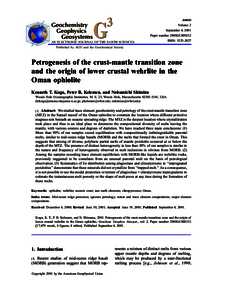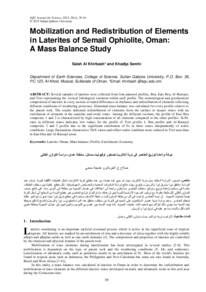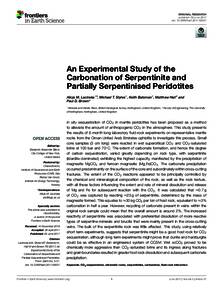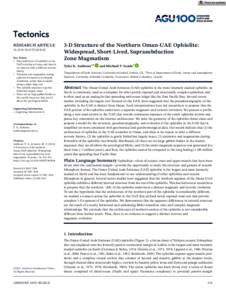Document
Petrogenesis of the crust-mantle transition zone and the origin of lower crustal wehrlite in the Oman ophiolite.
Identifier
DOI: 10.1029/2000GC000132
Source
Geochemistry, Geophysics, Geosystems. v. 2, 9
Contributors
Kelemen, Peter B., Author
Shimizu, Nobumichi., Author
Country
United States.
City
Hoboken
Publisher
Blackwell Publishing Ltd.
Gregorian
2001-09-01
Language
English
Subject
English abstract
We studied trace element geochemistry and petrology of the crust-mantle transition zone (MTZ) in the Samail massif of the Oman ophiolite to constrain the location where different primitive magmas mix beneath an oceanic spreading ridge. The MTZ is the deepest location where crystallization took place and thus is an ideal place to determine the compositional diversity of melts leaving the mantle, with various sources and degrees of depletion. We have reached three main conclusions: (1) More than 90% of our samples record equilibration with compositionally indistinguishable parental melts, similar to mid-ocean ridge basalts (MORB) and the melts that formed the crust in Oman. This suggests that mixing of diverse, polybaric partial melts of mantle peridotite occurred at or below the depth of the MTZ. The presence of distinct heterogeneity in less than 10% of our samples is similar to the nature and frequency of heterogeneity observed in melt inclusions in olivines from MORB. (2) Among the samples recording trace element equilibrium with MORB-like liquids are wehrlitic rocks, previously suggested to be cumulates from an unusual parental melt on the basis of petrological observation. (3) Systematics of Eu distribution among plagioclase and clinopyroxene in "impregnated peridotites" demonstrate that these minerals did not crystallize from "trapped melt." As a consequence, it is not possible to use the modal proportion or texture of plagioclase + clinopyroxene impregnations to estimate the instantaneous melt porosity or the shape of melt pores at any time during the formation of these rocks.
ISSN
1525-2027
Category
Journal articles




